Evaluating EHR Systems in the UK: A Systematic Review Proposal
VerifiedAdded on 2023/06/14
|39
|9885
|362
Report
AI Summary
This report presents a research proposal focused on evaluating the effectiveness of Electronic Health Records (EHRs) within the UK healthcare system and identifying the challenges associated with their implementation. It begins by providing a background on EHRs, highlighting their potential to improve patient health and reduce medication errors, while also acknowledging the difficulties in their adoption. The proposal outlines the research objectives, which include exploring the current status of EHR systems in the UK and identifying implementation challenges. A qualitative systematic review of relevant articles will be conducted to address the research questions concerning the effectiveness of current EHR systems and the barriers to their implementation. The report details the literature search process, theoretical perspectives, methodology, ethical considerations, and limitations of the proposed systematic review. Ultimately, this research aims to inform healthcare practices by providing a clear understanding of the benefits and drawbacks of EHR systems, facilitating the integration of technological innovations into healthcare management.
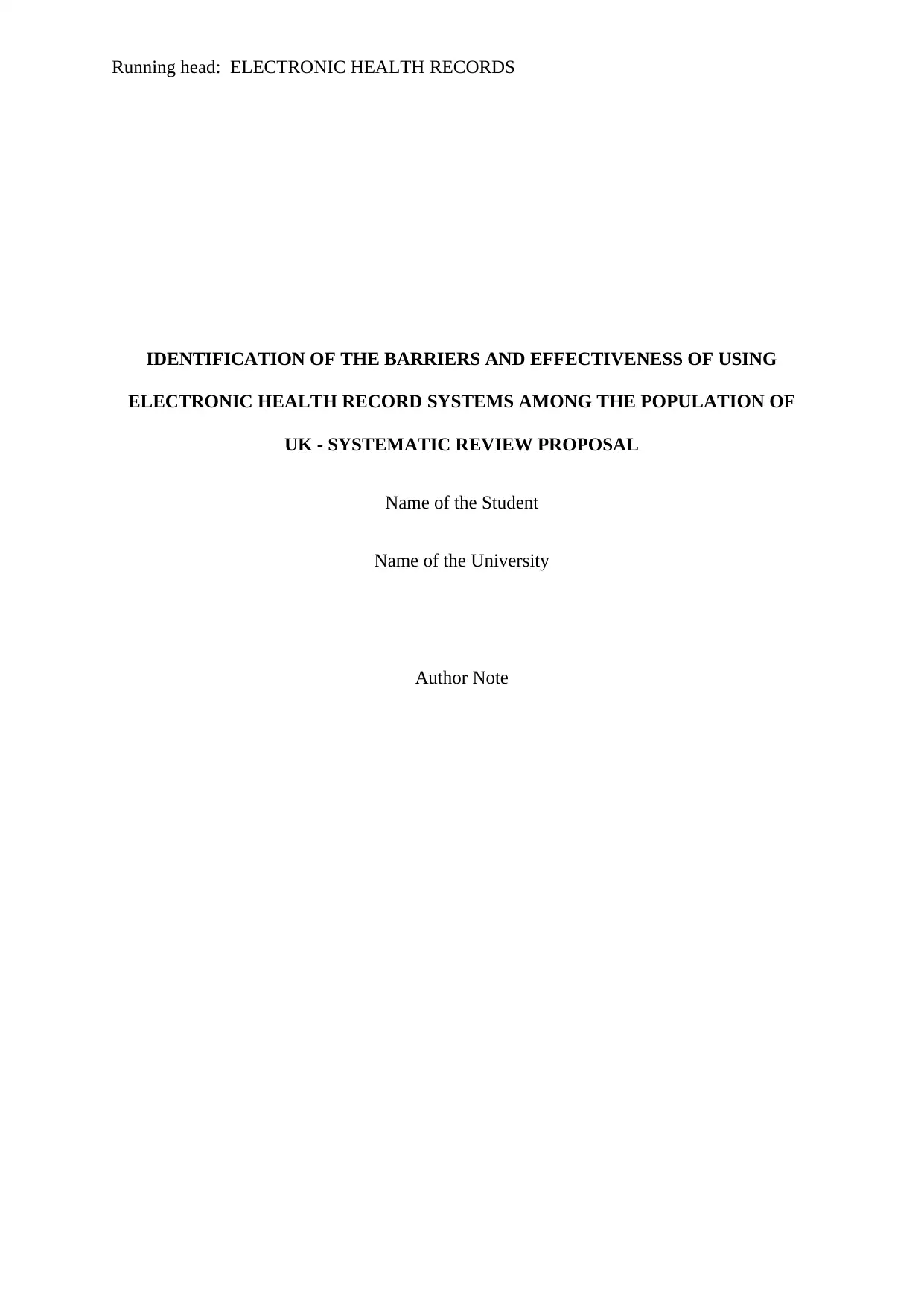
Running head: ELECTRONIC HEALTH RECORDS
IDENTIFICATION OF THE BARRIERS AND EFFECTIVENESS OF USING
ELECTRONIC HEALTH RECORD SYSTEMS AMONG THE POPULATION OF
UK - SYSTEMATIC REVIEW PROPOSAL
Name of the Student
Name of the University
Author Note
IDENTIFICATION OF THE BARRIERS AND EFFECTIVENESS OF USING
ELECTRONIC HEALTH RECORD SYSTEMS AMONG THE POPULATION OF
UK - SYSTEMATIC REVIEW PROPOSAL
Name of the Student
Name of the University
Author Note
Paraphrase This Document
Need a fresh take? Get an instant paraphrase of this document with our AI Paraphraser
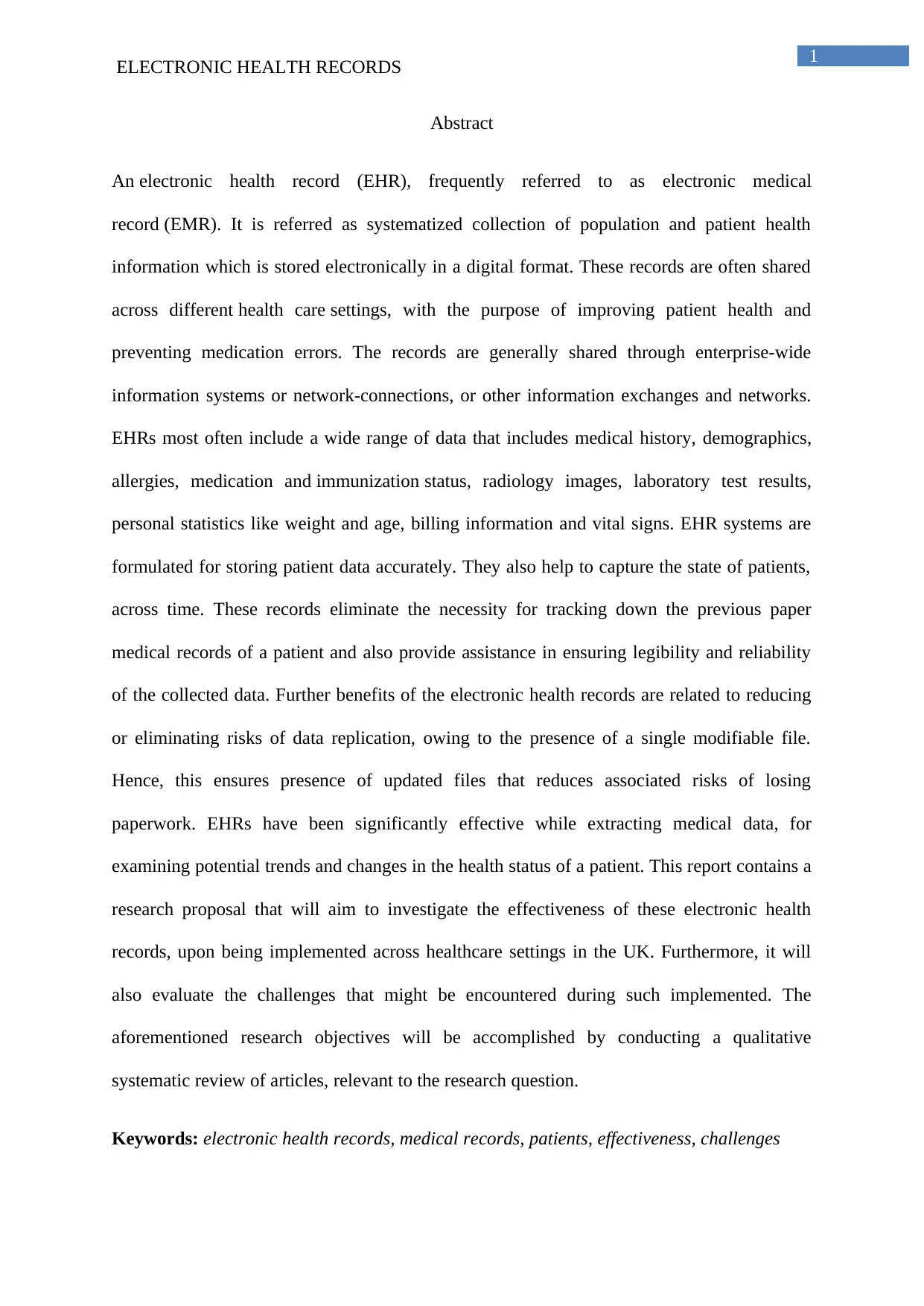
1
ELECTRONIC HEALTH RECORDS
Abstract
An electronic health record (EHR), frequently referred to as electronic medical
record (EMR). It is referred as systematized collection of population and patient health
information which is stored electronically in a digital format. These records are often shared
across different health care settings, with the purpose of improving patient health and
preventing medication errors. The records are generally shared through enterprise-wide
information systems or network-connections, or other information exchanges and networks.
EHRs most often include a wide range of data that includes medical history, demographics,
allergies, medication and immunization status, radiology images, laboratory test results,
personal statistics like weight and age, billing information and vital signs. EHR systems are
formulated for storing patient data accurately. They also help to capture the state of patients,
across time. These records eliminate the necessity for tracking down the previous paper
medical records of a patient and also provide assistance in ensuring legibility and reliability
of the collected data. Further benefits of the electronic health records are related to reducing
or eliminating risks of data replication, owing to the presence of a single modifiable file.
Hence, this ensures presence of updated files that reduces associated risks of losing
paperwork. EHRs have been significantly effective while extracting medical data, for
examining potential trends and changes in the health status of a patient. This report contains a
research proposal that will aim to investigate the effectiveness of these electronic health
records, upon being implemented across healthcare settings in the UK. Furthermore, it will
also evaluate the challenges that might be encountered during such implemented. The
aforementioned research objectives will be accomplished by conducting a qualitative
systematic review of articles, relevant to the research question.
Keywords: electronic health records, medical records, patients, effectiveness, challenges
ELECTRONIC HEALTH RECORDS
Abstract
An electronic health record (EHR), frequently referred to as electronic medical
record (EMR). It is referred as systematized collection of population and patient health
information which is stored electronically in a digital format. These records are often shared
across different health care settings, with the purpose of improving patient health and
preventing medication errors. The records are generally shared through enterprise-wide
information systems or network-connections, or other information exchanges and networks.
EHRs most often include a wide range of data that includes medical history, demographics,
allergies, medication and immunization status, radiology images, laboratory test results,
personal statistics like weight and age, billing information and vital signs. EHR systems are
formulated for storing patient data accurately. They also help to capture the state of patients,
across time. These records eliminate the necessity for tracking down the previous paper
medical records of a patient and also provide assistance in ensuring legibility and reliability
of the collected data. Further benefits of the electronic health records are related to reducing
or eliminating risks of data replication, owing to the presence of a single modifiable file.
Hence, this ensures presence of updated files that reduces associated risks of losing
paperwork. EHRs have been significantly effective while extracting medical data, for
examining potential trends and changes in the health status of a patient. This report contains a
research proposal that will aim to investigate the effectiveness of these electronic health
records, upon being implemented across healthcare settings in the UK. Furthermore, it will
also evaluate the challenges that might be encountered during such implemented. The
aforementioned research objectives will be accomplished by conducting a qualitative
systematic review of articles, relevant to the research question.
Keywords: electronic health records, medical records, patients, effectiveness, challenges
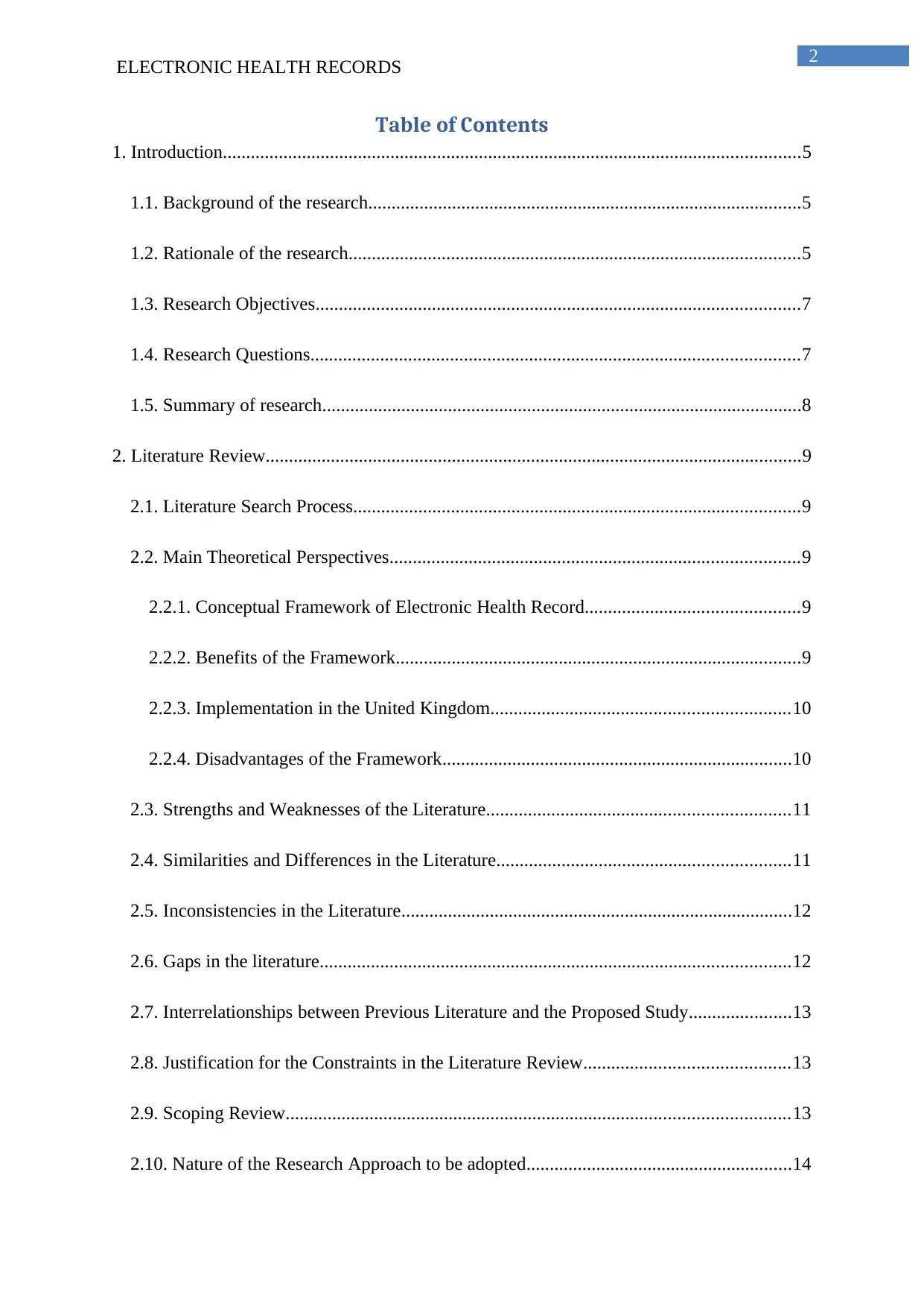
2
ELECTRONIC HEALTH RECORDS
Table of Contents
1. Introduction............................................................................................................................5
1.1. Background of the research.............................................................................................5
1.2. Rationale of the research.................................................................................................5
1.3. Research Objectives........................................................................................................7
1.4. Research Questions.........................................................................................................7
1.5. Summary of research.......................................................................................................8
2. Literature Review...................................................................................................................9
2.1. Literature Search Process................................................................................................9
2.2. Main Theoretical Perspectives........................................................................................9
2.2.1. Conceptual Framework of Electronic Health Record..............................................9
2.2.2. Benefits of the Framework.......................................................................................9
2.2.3. Implementation in the United Kingdom................................................................10
2.2.4. Disadvantages of the Framework...........................................................................10
2.3. Strengths and Weaknesses of the Literature.................................................................11
2.4. Similarities and Differences in the Literature...............................................................11
2.5. Inconsistencies in the Literature....................................................................................12
2.6. Gaps in the literature.....................................................................................................12
2.7. Interrelationships between Previous Literature and the Proposed Study......................13
2.8. Justification for the Constraints in the Literature Review............................................13
2.9. Scoping Review............................................................................................................13
2.10. Nature of the Research Approach to be adopted.........................................................14
ELECTRONIC HEALTH RECORDS
Table of Contents
1. Introduction............................................................................................................................5
1.1. Background of the research.............................................................................................5
1.2. Rationale of the research.................................................................................................5
1.3. Research Objectives........................................................................................................7
1.4. Research Questions.........................................................................................................7
1.5. Summary of research.......................................................................................................8
2. Literature Review...................................................................................................................9
2.1. Literature Search Process................................................................................................9
2.2. Main Theoretical Perspectives........................................................................................9
2.2.1. Conceptual Framework of Electronic Health Record..............................................9
2.2.2. Benefits of the Framework.......................................................................................9
2.2.3. Implementation in the United Kingdom................................................................10
2.2.4. Disadvantages of the Framework...........................................................................10
2.3. Strengths and Weaknesses of the Literature.................................................................11
2.4. Similarities and Differences in the Literature...............................................................11
2.5. Inconsistencies in the Literature....................................................................................12
2.6. Gaps in the literature.....................................................................................................12
2.7. Interrelationships between Previous Literature and the Proposed Study......................13
2.8. Justification for the Constraints in the Literature Review............................................13
2.9. Scoping Review............................................................................................................13
2.10. Nature of the Research Approach to be adopted.........................................................14
⊘ This is a preview!⊘
Do you want full access?
Subscribe today to unlock all pages.

Trusted by 1+ million students worldwide
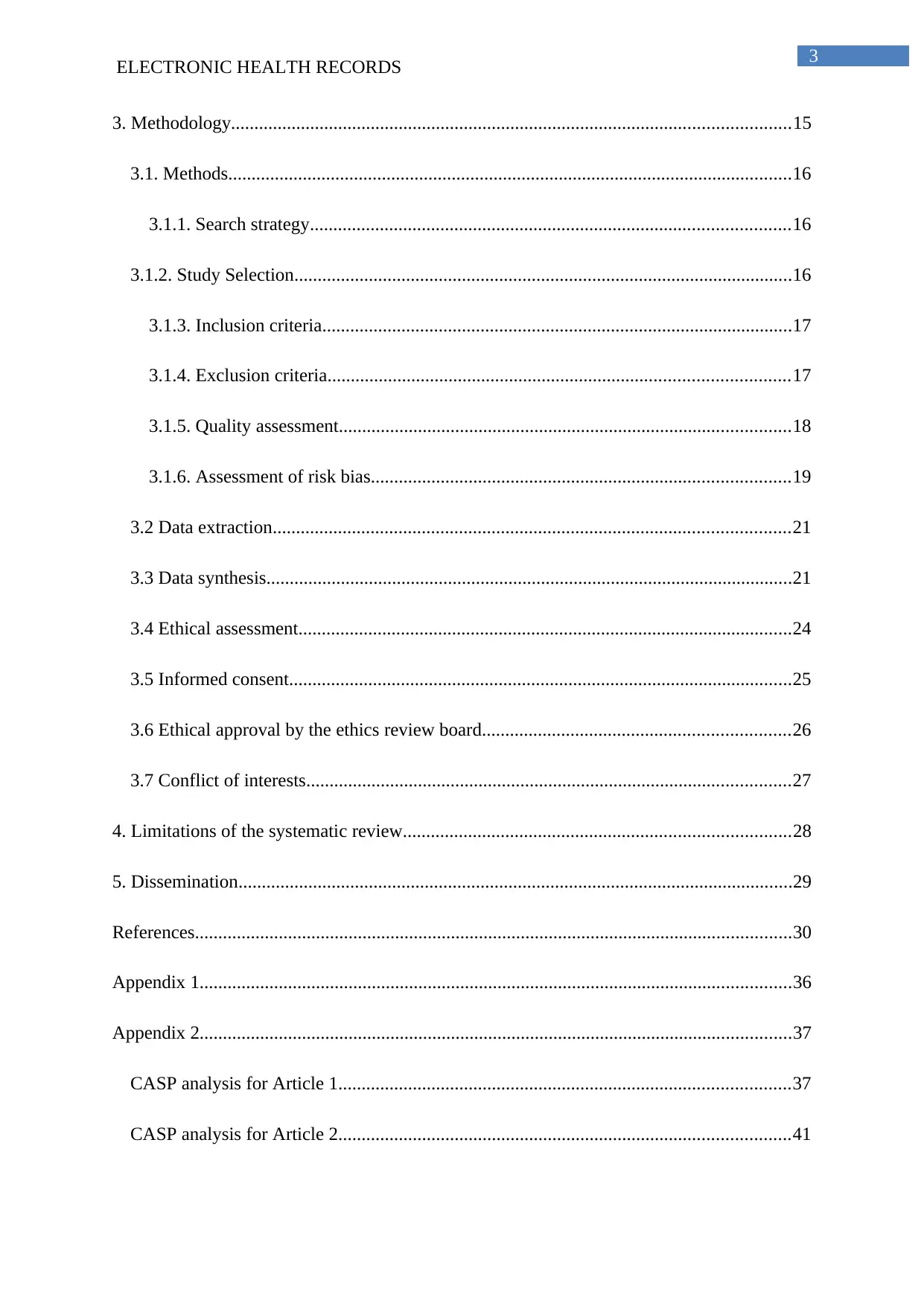
3
ELECTRONIC HEALTH RECORDS
3. Methodology........................................................................................................................15
3.1. Methods.........................................................................................................................16
3.1.1. Search strategy.......................................................................................................16
3.1.2. Study Selection...........................................................................................................16
3.1.3. Inclusion criteria.....................................................................................................17
3.1.4. Exclusion criteria...................................................................................................17
3.1.5. Quality assessment.................................................................................................18
3.1.6. Assessment of risk bias..........................................................................................19
3.2 Data extraction...............................................................................................................21
3.3 Data synthesis.................................................................................................................21
3.4 Ethical assessment..........................................................................................................24
3.5 Informed consent............................................................................................................25
3.6 Ethical approval by the ethics review board..................................................................26
3.7 Conflict of interests........................................................................................................27
4. Limitations of the systematic review...................................................................................28
5. Dissemination.......................................................................................................................29
References................................................................................................................................30
Appendix 1...............................................................................................................................36
Appendix 2...............................................................................................................................37
CASP analysis for Article 1.................................................................................................37
CASP analysis for Article 2.................................................................................................41
ELECTRONIC HEALTH RECORDS
3. Methodology........................................................................................................................15
3.1. Methods.........................................................................................................................16
3.1.1. Search strategy.......................................................................................................16
3.1.2. Study Selection...........................................................................................................16
3.1.3. Inclusion criteria.....................................................................................................17
3.1.4. Exclusion criteria...................................................................................................17
3.1.5. Quality assessment.................................................................................................18
3.1.6. Assessment of risk bias..........................................................................................19
3.2 Data extraction...............................................................................................................21
3.3 Data synthesis.................................................................................................................21
3.4 Ethical assessment..........................................................................................................24
3.5 Informed consent............................................................................................................25
3.6 Ethical approval by the ethics review board..................................................................26
3.7 Conflict of interests........................................................................................................27
4. Limitations of the systematic review...................................................................................28
5. Dissemination.......................................................................................................................29
References................................................................................................................................30
Appendix 1...............................................................................................................................36
Appendix 2...............................................................................................................................37
CASP analysis for Article 1.................................................................................................37
CASP analysis for Article 2.................................................................................................41
Paraphrase This Document
Need a fresh take? Get an instant paraphrase of this document with our AI Paraphraser
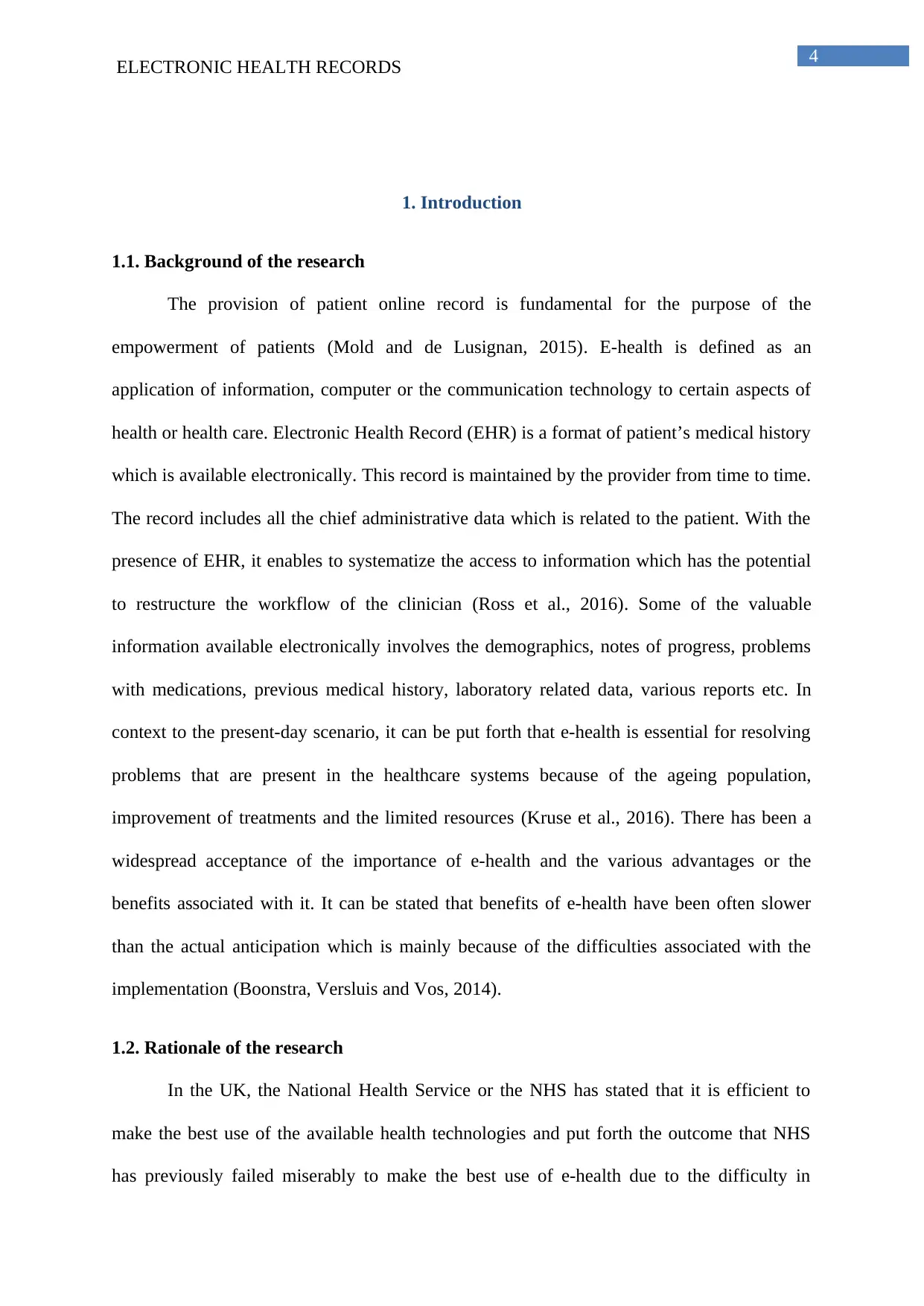
4
ELECTRONIC HEALTH RECORDS
1. Introduction
1.1. Background of the research
The provision of patient online record is fundamental for the purpose of the
empowerment of patients (Mold and de Lusignan, 2015). E-health is defined as an
application of information, computer or the communication technology to certain aspects of
health or health care. Electronic Health Record (EHR) is a format of patient’s medical history
which is available electronically. This record is maintained by the provider from time to time.
The record includes all the chief administrative data which is related to the patient. With the
presence of EHR, it enables to systematize the access to information which has the potential
to restructure the workflow of the clinician (Ross et al., 2016). Some of the valuable
information available electronically involves the demographics, notes of progress, problems
with medications, previous medical history, laboratory related data, various reports etc. In
context to the present-day scenario, it can be put forth that e-health is essential for resolving
problems that are present in the healthcare systems because of the ageing population,
improvement of treatments and the limited resources (Kruse et al., 2016). There has been a
widespread acceptance of the importance of e-health and the various advantages or the
benefits associated with it. It can be stated that benefits of e-health have been often slower
than the actual anticipation which is mainly because of the difficulties associated with the
implementation (Boonstra, Versluis and Vos, 2014).
1.2. Rationale of the research
In the UK, the National Health Service or the NHS has stated that it is efficient to
make the best use of the available health technologies and put forth the outcome that NHS
has previously failed miserably to make the best use of e-health due to the difficulty in
ELECTRONIC HEALTH RECORDS
1. Introduction
1.1. Background of the research
The provision of patient online record is fundamental for the purpose of the
empowerment of patients (Mold and de Lusignan, 2015). E-health is defined as an
application of information, computer or the communication technology to certain aspects of
health or health care. Electronic Health Record (EHR) is a format of patient’s medical history
which is available electronically. This record is maintained by the provider from time to time.
The record includes all the chief administrative data which is related to the patient. With the
presence of EHR, it enables to systematize the access to information which has the potential
to restructure the workflow of the clinician (Ross et al., 2016). Some of the valuable
information available electronically involves the demographics, notes of progress, problems
with medications, previous medical history, laboratory related data, various reports etc. In
context to the present-day scenario, it can be put forth that e-health is essential for resolving
problems that are present in the healthcare systems because of the ageing population,
improvement of treatments and the limited resources (Kruse et al., 2016). There has been a
widespread acceptance of the importance of e-health and the various advantages or the
benefits associated with it. It can be stated that benefits of e-health have been often slower
than the actual anticipation which is mainly because of the difficulties associated with the
implementation (Boonstra, Versluis and Vos, 2014).
1.2. Rationale of the research
In the UK, the National Health Service or the NHS has stated that it is efficient to
make the best use of the available health technologies and put forth the outcome that NHS
has previously failed miserably to make the best use of e-health due to the difficulty in
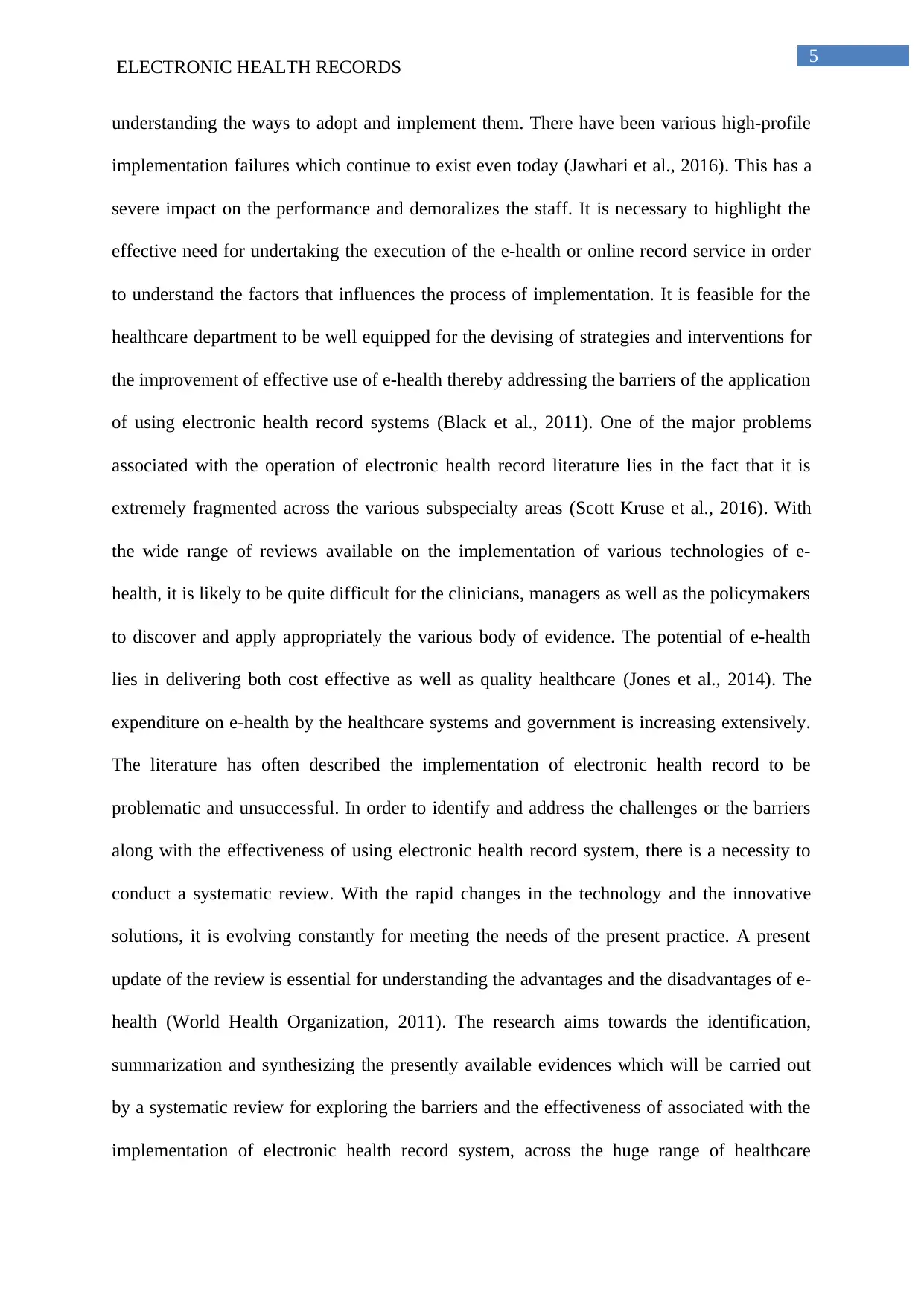
5
ELECTRONIC HEALTH RECORDS
understanding the ways to adopt and implement them. There have been various high-profile
implementation failures which continue to exist even today (Jawhari et al., 2016). This has a
severe impact on the performance and demoralizes the staff. It is necessary to highlight the
effective need for undertaking the execution of the e-health or online record service in order
to understand the factors that influences the process of implementation. It is feasible for the
healthcare department to be well equipped for the devising of strategies and interventions for
the improvement of effective use of e-health thereby addressing the barriers of the application
of using electronic health record systems (Black et al., 2011). One of the major problems
associated with the operation of electronic health record literature lies in the fact that it is
extremely fragmented across the various subspecialty areas (Scott Kruse et al., 2016). With
the wide range of reviews available on the implementation of various technologies of e-
health, it is likely to be quite difficult for the clinicians, managers as well as the policymakers
to discover and apply appropriately the various body of evidence. The potential of e-health
lies in delivering both cost effective as well as quality healthcare (Jones et al., 2014). The
expenditure on e-health by the healthcare systems and government is increasing extensively.
The literature has often described the implementation of electronic health record to be
problematic and unsuccessful. In order to identify and address the challenges or the barriers
along with the effectiveness of using electronic health record system, there is a necessity to
conduct a systematic review. With the rapid changes in the technology and the innovative
solutions, it is evolving constantly for meeting the needs of the present practice. A present
update of the review is essential for understanding the advantages and the disadvantages of e-
health (World Health Organization, 2011). The research aims towards the identification,
summarization and synthesizing the presently available evidences which will be carried out
by a systematic review for exploring the barriers and the effectiveness of associated with the
implementation of electronic health record system, across the huge range of healthcare
ELECTRONIC HEALTH RECORDS
understanding the ways to adopt and implement them. There have been various high-profile
implementation failures which continue to exist even today (Jawhari et al., 2016). This has a
severe impact on the performance and demoralizes the staff. It is necessary to highlight the
effective need for undertaking the execution of the e-health or online record service in order
to understand the factors that influences the process of implementation. It is feasible for the
healthcare department to be well equipped for the devising of strategies and interventions for
the improvement of effective use of e-health thereby addressing the barriers of the application
of using electronic health record systems (Black et al., 2011). One of the major problems
associated with the operation of electronic health record literature lies in the fact that it is
extremely fragmented across the various subspecialty areas (Scott Kruse et al., 2016). With
the wide range of reviews available on the implementation of various technologies of e-
health, it is likely to be quite difficult for the clinicians, managers as well as the policymakers
to discover and apply appropriately the various body of evidence. The potential of e-health
lies in delivering both cost effective as well as quality healthcare (Jones et al., 2014). The
expenditure on e-health by the healthcare systems and government is increasing extensively.
The literature has often described the implementation of electronic health record to be
problematic and unsuccessful. In order to identify and address the challenges or the barriers
along with the effectiveness of using electronic health record system, there is a necessity to
conduct a systematic review. With the rapid changes in the technology and the innovative
solutions, it is evolving constantly for meeting the needs of the present practice. A present
update of the review is essential for understanding the advantages and the disadvantages of e-
health (World Health Organization, 2011). The research aims towards the identification,
summarization and synthesizing the presently available evidences which will be carried out
by a systematic review for exploring the barriers and the effectiveness of associated with the
implementation of electronic health record system, across the huge range of healthcare
⊘ This is a preview!⊘
Do you want full access?
Subscribe today to unlock all pages.

Trusted by 1+ million students worldwide
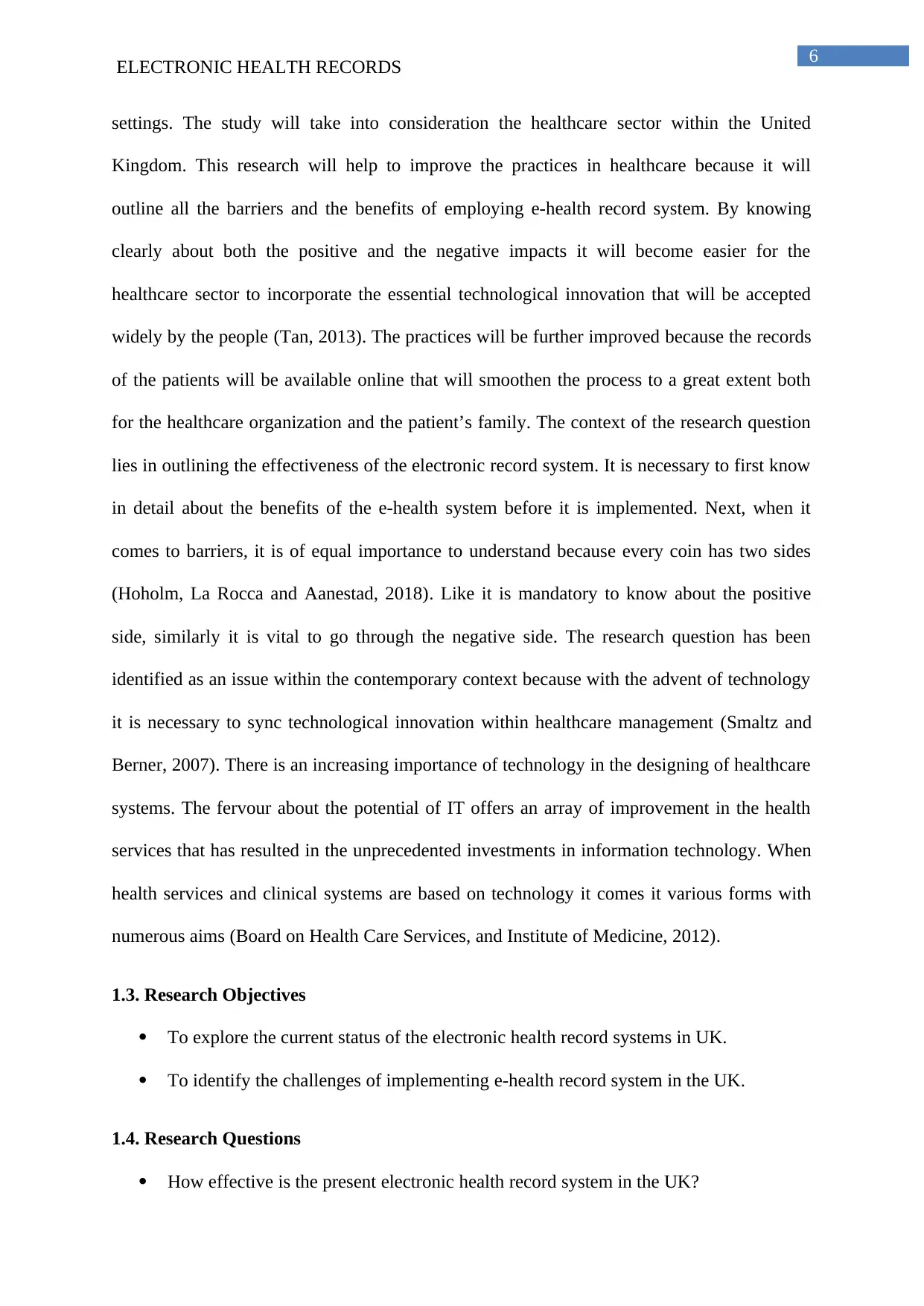
6
ELECTRONIC HEALTH RECORDS
settings. The study will take into consideration the healthcare sector within the United
Kingdom. This research will help to improve the practices in healthcare because it will
outline all the barriers and the benefits of employing e-health record system. By knowing
clearly about both the positive and the negative impacts it will become easier for the
healthcare sector to incorporate the essential technological innovation that will be accepted
widely by the people (Tan, 2013). The practices will be further improved because the records
of the patients will be available online that will smoothen the process to a great extent both
for the healthcare organization and the patient’s family. The context of the research question
lies in outlining the effectiveness of the electronic record system. It is necessary to first know
in detail about the benefits of the e-health system before it is implemented. Next, when it
comes to barriers, it is of equal importance to understand because every coin has two sides
(Hoholm, La Rocca and Aanestad, 2018). Like it is mandatory to know about the positive
side, similarly it is vital to go through the negative side. The research question has been
identified as an issue within the contemporary context because with the advent of technology
it is necessary to sync technological innovation within healthcare management (Smaltz and
Berner, 2007). There is an increasing importance of technology in the designing of healthcare
systems. The fervour about the potential of IT offers an array of improvement in the health
services that has resulted in the unprecedented investments in information technology. When
health services and clinical systems are based on technology it comes it various forms with
numerous aims (Board on Health Care Services, and Institute of Medicine, 2012).
1.3. Research Objectives
To explore the current status of the electronic health record systems in UK.
To identify the challenges of implementing e-health record system in the UK.
1.4. Research Questions
How effective is the present electronic health record system in the UK?
ELECTRONIC HEALTH RECORDS
settings. The study will take into consideration the healthcare sector within the United
Kingdom. This research will help to improve the practices in healthcare because it will
outline all the barriers and the benefits of employing e-health record system. By knowing
clearly about both the positive and the negative impacts it will become easier for the
healthcare sector to incorporate the essential technological innovation that will be accepted
widely by the people (Tan, 2013). The practices will be further improved because the records
of the patients will be available online that will smoothen the process to a great extent both
for the healthcare organization and the patient’s family. The context of the research question
lies in outlining the effectiveness of the electronic record system. It is necessary to first know
in detail about the benefits of the e-health system before it is implemented. Next, when it
comes to barriers, it is of equal importance to understand because every coin has two sides
(Hoholm, La Rocca and Aanestad, 2018). Like it is mandatory to know about the positive
side, similarly it is vital to go through the negative side. The research question has been
identified as an issue within the contemporary context because with the advent of technology
it is necessary to sync technological innovation within healthcare management (Smaltz and
Berner, 2007). There is an increasing importance of technology in the designing of healthcare
systems. The fervour about the potential of IT offers an array of improvement in the health
services that has resulted in the unprecedented investments in information technology. When
health services and clinical systems are based on technology it comes it various forms with
numerous aims (Board on Health Care Services, and Institute of Medicine, 2012).
1.3. Research Objectives
To explore the current status of the electronic health record systems in UK.
To identify the challenges of implementing e-health record system in the UK.
1.4. Research Questions
How effective is the present electronic health record system in the UK?
Paraphrase This Document
Need a fresh take? Get an instant paraphrase of this document with our AI Paraphraser
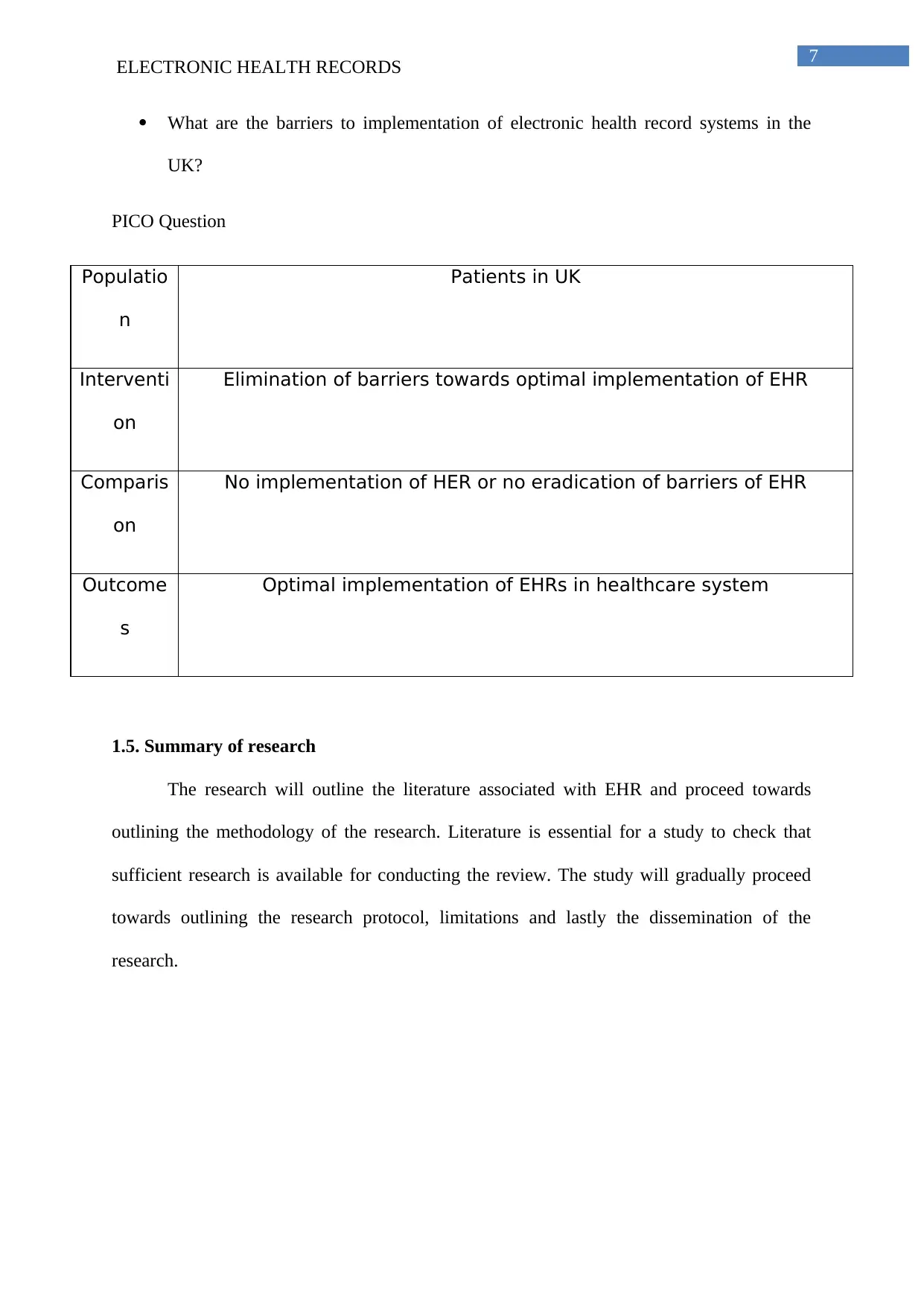
7
ELECTRONIC HEALTH RECORDS
What are the barriers to implementation of electronic health record systems in the
UK?
PICO Question
Populatio
n
Patients in UK
Interventi
on
Elimination of barriers towards optimal implementation of EHR
Comparis
on
No implementation of HER or no eradication of barriers of EHR
Outcome
s
Optimal implementation of EHRs in healthcare system
1.5. Summary of research
The research will outline the literature associated with EHR and proceed towards
outlining the methodology of the research. Literature is essential for a study to check that
sufficient research is available for conducting the review. The study will gradually proceed
towards outlining the research protocol, limitations and lastly the dissemination of the
research.
ELECTRONIC HEALTH RECORDS
What are the barriers to implementation of electronic health record systems in the
UK?
PICO Question
Populatio
n
Patients in UK
Interventi
on
Elimination of barriers towards optimal implementation of EHR
Comparis
on
No implementation of HER or no eradication of barriers of EHR
Outcome
s
Optimal implementation of EHRs in healthcare system
1.5. Summary of research
The research will outline the literature associated with EHR and proceed towards
outlining the methodology of the research. Literature is essential for a study to check that
sufficient research is available for conducting the review. The study will gradually proceed
towards outlining the research protocol, limitations and lastly the dissemination of the
research.
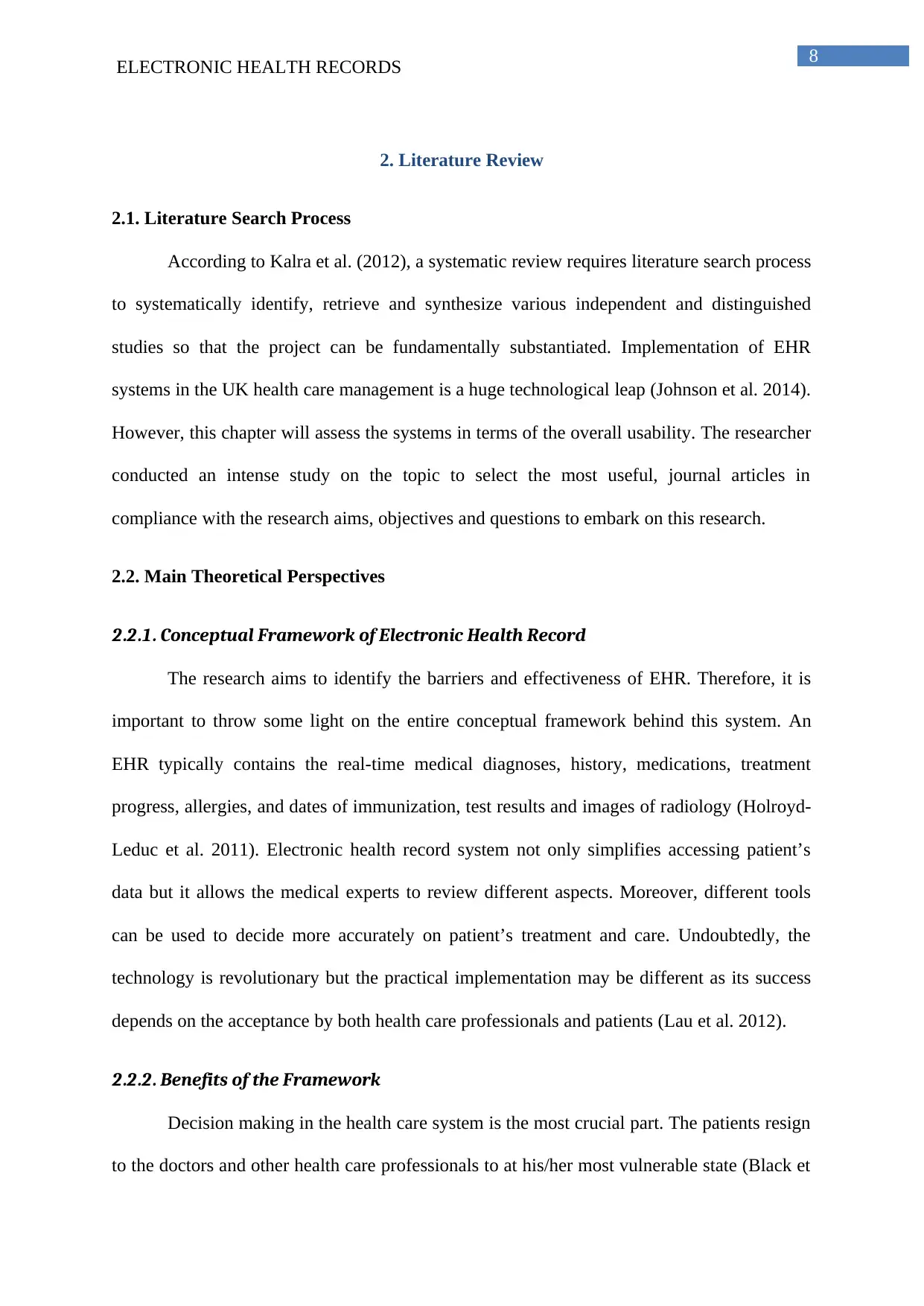
8
ELECTRONIC HEALTH RECORDS
2. Literature Review
2.1. Literature Search Process
According to Kalra et al. (2012), a systematic review requires literature search process
to systematically identify, retrieve and synthesize various independent and distinguished
studies so that the project can be fundamentally substantiated. Implementation of EHR
systems in the UK health care management is a huge technological leap (Johnson et al. 2014).
However, this chapter will assess the systems in terms of the overall usability. The researcher
conducted an intense study on the topic to select the most useful, journal articles in
compliance with the research aims, objectives and questions to embark on this research.
2.2. Main Theoretical Perspectives
2.2.1. Conceptual Framework of Electronic Health Record
The research aims to identify the barriers and effectiveness of EHR. Therefore, it is
important to throw some light on the entire conceptual framework behind this system. An
EHR typically contains the real-time medical diagnoses, history, medications, treatment
progress, allergies, and dates of immunization, test results and images of radiology (Holroyd-
Leduc et al. 2011). Electronic health record system not only simplifies accessing patient’s
data but it allows the medical experts to review different aspects. Moreover, different tools
can be used to decide more accurately on patient’s treatment and care. Undoubtedly, the
technology is revolutionary but the practical implementation may be different as its success
depends on the acceptance by both health care professionals and patients (Lau et al. 2012).
2.2.2. Benefits of the Framework
Decision making in the health care system is the most crucial part. The patients resign
to the doctors and other health care professionals to at his/her most vulnerable state (Black et
ELECTRONIC HEALTH RECORDS
2. Literature Review
2.1. Literature Search Process
According to Kalra et al. (2012), a systematic review requires literature search process
to systematically identify, retrieve and synthesize various independent and distinguished
studies so that the project can be fundamentally substantiated. Implementation of EHR
systems in the UK health care management is a huge technological leap (Johnson et al. 2014).
However, this chapter will assess the systems in terms of the overall usability. The researcher
conducted an intense study on the topic to select the most useful, journal articles in
compliance with the research aims, objectives and questions to embark on this research.
2.2. Main Theoretical Perspectives
2.2.1. Conceptual Framework of Electronic Health Record
The research aims to identify the barriers and effectiveness of EHR. Therefore, it is
important to throw some light on the entire conceptual framework behind this system. An
EHR typically contains the real-time medical diagnoses, history, medications, treatment
progress, allergies, and dates of immunization, test results and images of radiology (Holroyd-
Leduc et al. 2011). Electronic health record system not only simplifies accessing patient’s
data but it allows the medical experts to review different aspects. Moreover, different tools
can be used to decide more accurately on patient’s treatment and care. Undoubtedly, the
technology is revolutionary but the practical implementation may be different as its success
depends on the acceptance by both health care professionals and patients (Lau et al. 2012).
2.2.2. Benefits of the Framework
Decision making in the health care system is the most crucial part. The patients resign
to the doctors and other health care professionals to at his/her most vulnerable state (Black et
⊘ This is a preview!⊘
Do you want full access?
Subscribe today to unlock all pages.

Trusted by 1+ million students worldwide

9
ELECTRONIC HEALTH RECORDS
al. 2011). Therefore, it is important to take advanced measures to perfect patient care and
treatment. The highlights of the benefits of EHR include real-time reporting, quick access to
patient’s data, optimized decision support, medical information, clinical reminders, instant
measures and fewer paper works and easy tracking of patient’s curing and treatment progress
(McGinn et al. 2011).
2.2.3. Implementation in the United Kingdom
The government of United Kingdom incorporated electronic health record system as
the part of National Programme for Information Technology NHS Record Service in 2002
(Ajami and Bagheri-Tadi, 2013). The project miserably failed and eventually was officially
dismantled in 2011 (Menachemi and Collum, 2011). Considering the status, Wales, Northern
Ireland and Scotland have succeeded with implementing and using the electronic health
record systems and the electronic health record of Northern Ireland has been awarded
industry awards (Carrington and Effken, 2011). Moreover, the system at present is limited to
share only the adverse reactions, allergies and prescriptions. The sharing radius is also
restricted to GP surgeries, hospitals, community pharmacists and walk-in centres (King et al.
2014).
2.2.4. Disadvantages of the Framework
In order to implement electronic health record, the health care organizations have to
bear an enormous start-up cost and eventually a maintenance cost. That amount is not less.
According to Hersh et al. (2013), the average cost of implementing electronic health record
system is $162,000 approximately and the maintenance cost during the first year is $85,500.
Over the time, this cost is expected to increase and this really makes difficult to rapidly
implement the system in all health care centres. Another major disadvantage is the data
vulnerability. There may be different security measures available for virtual data, but the
ELECTRONIC HEALTH RECORDS
al. 2011). Therefore, it is important to take advanced measures to perfect patient care and
treatment. The highlights of the benefits of EHR include real-time reporting, quick access to
patient’s data, optimized decision support, medical information, clinical reminders, instant
measures and fewer paper works and easy tracking of patient’s curing and treatment progress
(McGinn et al. 2011).
2.2.3. Implementation in the United Kingdom
The government of United Kingdom incorporated electronic health record system as
the part of National Programme for Information Technology NHS Record Service in 2002
(Ajami and Bagheri-Tadi, 2013). The project miserably failed and eventually was officially
dismantled in 2011 (Menachemi and Collum, 2011). Considering the status, Wales, Northern
Ireland and Scotland have succeeded with implementing and using the electronic health
record systems and the electronic health record of Northern Ireland has been awarded
industry awards (Carrington and Effken, 2011). Moreover, the system at present is limited to
share only the adverse reactions, allergies and prescriptions. The sharing radius is also
restricted to GP surgeries, hospitals, community pharmacists and walk-in centres (King et al.
2014).
2.2.4. Disadvantages of the Framework
In order to implement electronic health record, the health care organizations have to
bear an enormous start-up cost and eventually a maintenance cost. That amount is not less.
According to Hersh et al. (2013), the average cost of implementing electronic health record
system is $162,000 approximately and the maintenance cost during the first year is $85,500.
Over the time, this cost is expected to increase and this really makes difficult to rapidly
implement the system in all health care centres. Another major disadvantage is the data
vulnerability. There may be different security measures available for virtual data, but the
Paraphrase This Document
Need a fresh take? Get an instant paraphrase of this document with our AI Paraphraser
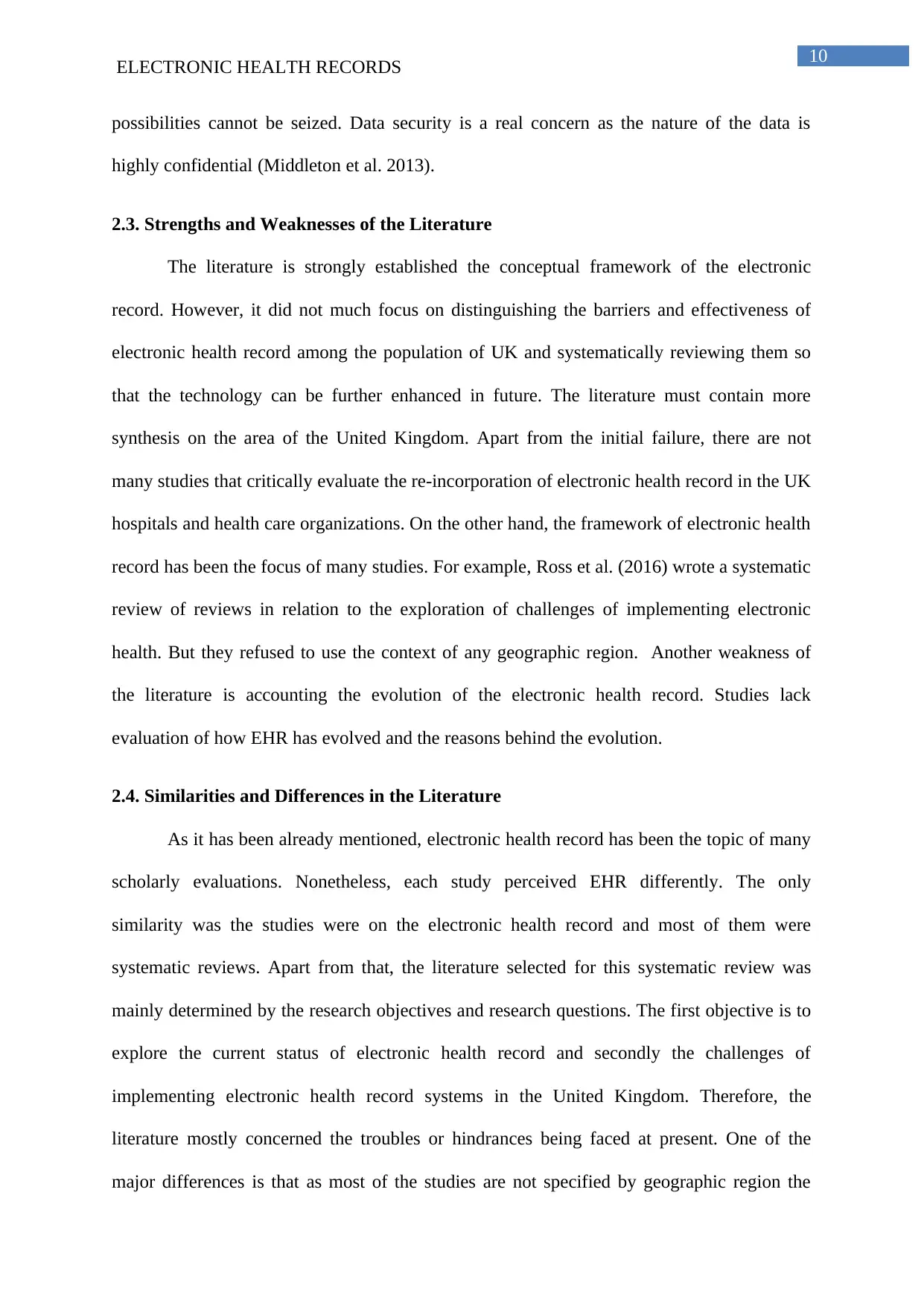
10
ELECTRONIC HEALTH RECORDS
possibilities cannot be seized. Data security is a real concern as the nature of the data is
highly confidential (Middleton et al. 2013).
2.3. Strengths and Weaknesses of the Literature
The literature is strongly established the conceptual framework of the electronic
record. However, it did not much focus on distinguishing the barriers and effectiveness of
electronic health record among the population of UK and systematically reviewing them so
that the technology can be further enhanced in future. The literature must contain more
synthesis on the area of the United Kingdom. Apart from the initial failure, there are not
many studies that critically evaluate the re-incorporation of electronic health record in the UK
hospitals and health care organizations. On the other hand, the framework of electronic health
record has been the focus of many studies. For example, Ross et al. (2016) wrote a systematic
review of reviews in relation to the exploration of challenges of implementing electronic
health. But they refused to use the context of any geographic region. Another weakness of
the literature is accounting the evolution of the electronic health record. Studies lack
evaluation of how EHR has evolved and the reasons behind the evolution.
2.4. Similarities and Differences in the Literature
As it has been already mentioned, electronic health record has been the topic of many
scholarly evaluations. Nonetheless, each study perceived EHR differently. The only
similarity was the studies were on the electronic health record and most of them were
systematic reviews. Apart from that, the literature selected for this systematic review was
mainly determined by the research objectives and research questions. The first objective is to
explore the current status of electronic health record and secondly the challenges of
implementing electronic health record systems in the United Kingdom. Therefore, the
literature mostly concerned the troubles or hindrances being faced at present. One of the
major differences is that as most of the studies are not specified by geographic region the
ELECTRONIC HEALTH RECORDS
possibilities cannot be seized. Data security is a real concern as the nature of the data is
highly confidential (Middleton et al. 2013).
2.3. Strengths and Weaknesses of the Literature
The literature is strongly established the conceptual framework of the electronic
record. However, it did not much focus on distinguishing the barriers and effectiveness of
electronic health record among the population of UK and systematically reviewing them so
that the technology can be further enhanced in future. The literature must contain more
synthesis on the area of the United Kingdom. Apart from the initial failure, there are not
many studies that critically evaluate the re-incorporation of electronic health record in the UK
hospitals and health care organizations. On the other hand, the framework of electronic health
record has been the focus of many studies. For example, Ross et al. (2016) wrote a systematic
review of reviews in relation to the exploration of challenges of implementing electronic
health. But they refused to use the context of any geographic region. Another weakness of
the literature is accounting the evolution of the electronic health record. Studies lack
evaluation of how EHR has evolved and the reasons behind the evolution.
2.4. Similarities and Differences in the Literature
As it has been already mentioned, electronic health record has been the topic of many
scholarly evaluations. Nonetheless, each study perceived EHR differently. The only
similarity was the studies were on the electronic health record and most of them were
systematic reviews. Apart from that, the literature selected for this systematic review was
mainly determined by the research objectives and research questions. The first objective is to
explore the current status of electronic health record and secondly the challenges of
implementing electronic health record systems in the United Kingdom. Therefore, the
literature mostly concerned the troubles or hindrances being faced at present. One of the
major differences is that as most of the studies are not specified by geographic region the
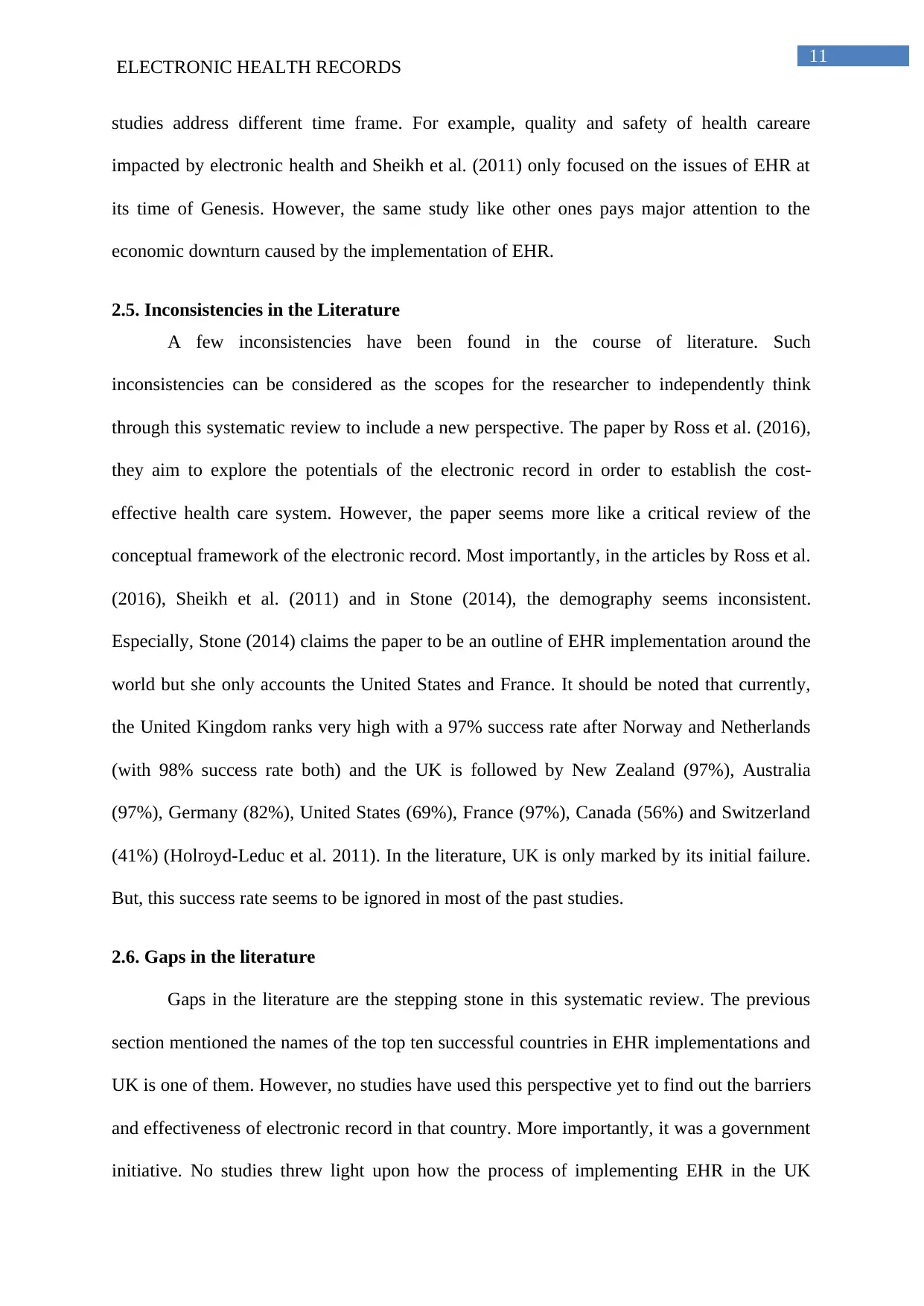
11
ELECTRONIC HEALTH RECORDS
studies address different time frame. For example, quality and safety of health careare
impacted by electronic health and Sheikh et al. (2011) only focused on the issues of EHR at
its time of Genesis. However, the same study like other ones pays major attention to the
economic downturn caused by the implementation of EHR.
2.5. Inconsistencies in the Literature
A few inconsistencies have been found in the course of literature. Such
inconsistencies can be considered as the scopes for the researcher to independently think
through this systematic review to include a new perspective. The paper by Ross et al. (2016),
they aim to explore the potentials of the electronic record in order to establish the cost-
effective health care system. However, the paper seems more like a critical review of the
conceptual framework of the electronic record. Most importantly, in the articles by Ross et al.
(2016), Sheikh et al. (2011) and in Stone (2014), the demography seems inconsistent.
Especially, Stone (2014) claims the paper to be an outline of EHR implementation around the
world but she only accounts the United States and France. It should be noted that currently,
the United Kingdom ranks very high with a 97% success rate after Norway and Netherlands
(with 98% success rate both) and the UK is followed by New Zealand (97%), Australia
(97%), Germany (82%), United States (69%), France (97%), Canada (56%) and Switzerland
(41%) (Holroyd-Leduc et al. 2011). In the literature, UK is only marked by its initial failure.
But, this success rate seems to be ignored in most of the past studies.
2.6. Gaps in the literature
Gaps in the literature are the stepping stone in this systematic review. The previous
section mentioned the names of the top ten successful countries in EHR implementations and
UK is one of them. However, no studies have used this perspective yet to find out the barriers
and effectiveness of electronic record in that country. More importantly, it was a government
initiative. No studies threw light upon how the process of implementing EHR in the UK
ELECTRONIC HEALTH RECORDS
studies address different time frame. For example, quality and safety of health careare
impacted by electronic health and Sheikh et al. (2011) only focused on the issues of EHR at
its time of Genesis. However, the same study like other ones pays major attention to the
economic downturn caused by the implementation of EHR.
2.5. Inconsistencies in the Literature
A few inconsistencies have been found in the course of literature. Such
inconsistencies can be considered as the scopes for the researcher to independently think
through this systematic review to include a new perspective. The paper by Ross et al. (2016),
they aim to explore the potentials of the electronic record in order to establish the cost-
effective health care system. However, the paper seems more like a critical review of the
conceptual framework of the electronic record. Most importantly, in the articles by Ross et al.
(2016), Sheikh et al. (2011) and in Stone (2014), the demography seems inconsistent.
Especially, Stone (2014) claims the paper to be an outline of EHR implementation around the
world but she only accounts the United States and France. It should be noted that currently,
the United Kingdom ranks very high with a 97% success rate after Norway and Netherlands
(with 98% success rate both) and the UK is followed by New Zealand (97%), Australia
(97%), Germany (82%), United States (69%), France (97%), Canada (56%) and Switzerland
(41%) (Holroyd-Leduc et al. 2011). In the literature, UK is only marked by its initial failure.
But, this success rate seems to be ignored in most of the past studies.
2.6. Gaps in the literature
Gaps in the literature are the stepping stone in this systematic review. The previous
section mentioned the names of the top ten successful countries in EHR implementations and
UK is one of them. However, no studies have used this perspective yet to find out the barriers
and effectiveness of electronic record in that country. More importantly, it was a government
initiative. No studies threw light upon how the process of implementing EHR in the UK
⊘ This is a preview!⊘
Do you want full access?
Subscribe today to unlock all pages.

Trusted by 1+ million students worldwide
1 out of 39
Related Documents
Your All-in-One AI-Powered Toolkit for Academic Success.
+13062052269
info@desklib.com
Available 24*7 on WhatsApp / Email
![[object Object]](/_next/static/media/star-bottom.7253800d.svg)
Unlock your academic potential
Copyright © 2020–2025 A2Z Services. All Rights Reserved. Developed and managed by ZUCOL.





